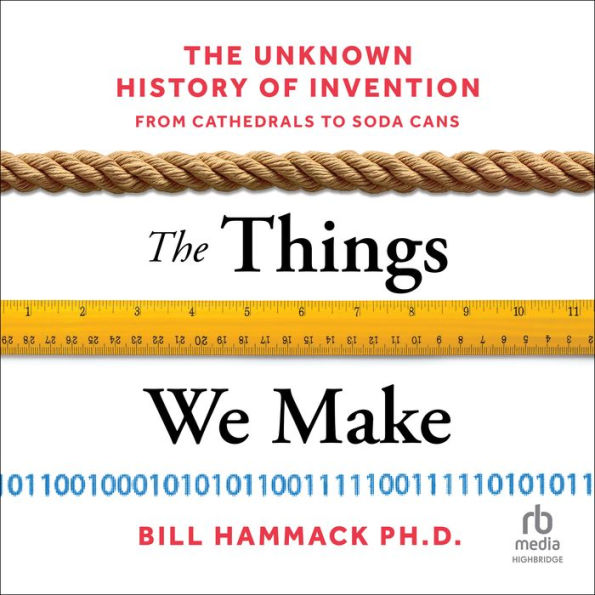Publishers Weekly
★ 10/24/2022
Chemical engineer Hammack (Eight Amazing Engineering Stories) makes a fascinating case that engineering isn’t the same as science in this sweeping history. He defines engineering as “solving problems using rules of thumb that cause the best change in a poorly understood situation using available resources,” and suggests that such problem-solving is “the force that has created the human world as we know it.” He begins with medieval cathedrals—immense, beautiful, and durable structures built by masons using “experience-derived, provisional guidelines, none of which guarantee a correct answer, yet when woven together create works of stunning utility, reliability, and beauty”—and hopscotches forward through breakthroughs in, for instance, ceramics that were made thanks to “key strategies of the engineering method” (including “building on past knowledge” and “accepting trade-offs”), and the advent of the microwave oven, which became ubiquitous despite being “a failed version of what the Raytheon engineers were trying to build.” Hammack brilliantly delineates the role of trial and error in human progress, and presents a knockout argument that a perfect understanding of the world is not a prerequisite to innovation. This clever and curious account delivers. (Mar.)
From the Publisher
"Bill Hammack’s book is a fascinating journey about how engineers and inventors actually work and proves that everyone—engineers, scientists and even you and me—can create useful things by tinkering. A great book and enjoyable read." — Don Norman, engineer, designer, and bestselling author of The Design of Everyday Things and Design for a Better World
"A fascinating description of how engineers work, full of lively stories from engineering history, and an enlightening read." — Roland Ennos, author of The Age of Wood
"This brilliant book is packed with inspiring stories about clever, determined, patient but ultimately practical people. Hammack is on a mission to reshape the accepted science narrative." — Richard Mainwaring, author of What the Ear Hears (and Doesn’t)
"Hammack writes with admirable clarity, authority, and wisdom." — Kirkus Reviews
"This book unravels the mysteries behind humanity’s greatest masterpieces. Bill Hammack is not just an expert on designing and building—he’s a gifted communicator. His infectious enthusiasm leaps off the page as he reveals how you can learn to think like an engineer even if you don’t love math." — Adam Grant, #1 New York Times bestselling author of Think Again and host of the TED podcast Re:Thinking
"A delightful and illuminating tour of the clever solutions that engineers have devised through the centuries. This book brims with fascinating historical accounts of everything from an ancient grape juice-squeezing apparatus to a precisely-controlled 'candle clock,' while also giving us new appreciation for the humble everyday objects in our homes—bikes, microwaves, laundry detergent—that we take for granted." — Roberta Kwok, award-winning science journalist
"A fascinating case that engineering isn’t the same as science in this sweeping history… Hammack brilliantly delineates the role of trial and error in human progress, and presents a knockout argument that a perfect understanding of the world is not a prerequisite to innovation. This clever and curious account delivers." — Publishers Weekly
"We live in a wonderland of made things, from skyscrapers to skateboards, brought to us by the ingenious problem-solving, incremental improvements, and clever combinations of engineers. Yet few of us understand what engineering is. (Hint: not "applied science.") By highlighting the compelling stories of neglected innovators, Bill Hammack explains what exactly engineers do and why they deserve credit for the marvels, large and small, that surround us." — Virginia Postrel, author of The Fabric of Civilization: How Textiles Made the World
"There's splendor in the everyday but so much goes unnoticed: the design of your belongings, the alcoves in a building, the lean of a bicyclist on the sidewalk. These are things that, once seen, can't be unseen and in The Things We Make, your eyes will be opened." — Bookworm Sez
Kirkus Reviews
2022-09-29
An informative book about how the impulse of engineers to solve real-world problems is the source of progress.
Hammack, a professor of engineering at the University of Illinois and the award-winning creator of a YouTube channel called engineerguy, has the ability to break down complex subjects into simple steps. In this insightful book, he tackles the broad subject of engineering and how it underpins the world we live in. He believes that all engineering stems from a number of “rules of thumb,” and the aim is always to make something that works. “The scientific method creates knowledge; the engineering method creates solutions,” he writes. Progress occurs through systemized trial and error based on careful observation. This is not to say that engineers disdain science and mathematics but only to note that their emphasis is on the practical. Hammack points to several cases in which the underlying scientific principles were only worked out after an invention was up and running. Another strategy is to build on past knowledge, including the inventions of others. For example, the light bulb could not have been developed without the tungsten filaments that had already been invented. Another rule is to accept trade-offs. Engineers must balance constraints to arrive at an optimal—not necessarily perfect—solution. An invention might not have the theoretical elegance of a math equation, but the engineer doesn’t care as long as it gets the job done. Hammack explains his material in straightforward language, and in the concluding chapter, he makes a case for engineering to take place within a moral and ethical framework. The engineer’s capacity to make things that function well should be leavened by public debate on what shouldbe done, and an understanding of the processes involved. “To engineer,” writes the author, “cuts to the core of being human.”
Hammack writes with admirable clarity, authority, and wisdom.



